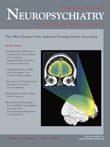Antipsychotic Induced Bruxism Treated with Clozapine
To the Editor: A variety of movement disorders, including bruxism, are known to occur with antipsychotic drugs. In few cases, movements do not disappear even several years after the withdrawal of causative agents, thus leading to permanent disability. We report a case of a patient with schizophrenia who developed chronic bruxism after exposure to multiple antipsychotics. A trial of clozapine resulted in complete remission.
Case Report
Mr. A, a 56-year-old man, was suffering from schizophrenia with frequent relapse and remission for the last 14 years. His symptoms were characterized by suspicious and withdrawn behavior, poor personal care, muttering, and inappropriate affect. Psychopharmacological treatment started 6 months after the onset of illness and he was exposed to optimum dosages of various antipsychotic drugs, such as chlorpromazine and trifluoperazine. At the end of 8 years of antipsychotic therapy, when he was taking tablet trifluoperazine (15 mg) and trihexiphenydil (4 mg), he developed bruxism of mixed typed—both grinding and clenching. The teeth movements were so obvious that others could hear them easily. These involuntary movements were observed only while he was awake. They were regular and rhythmic and would disappear while eating and speaking. Since he was in remission he was not given any antipsychotic drugs for the next 6 years and did not consult a psychiatrist, but he continued to exhibit bruxism. There were no reports of dental abnormalities. Use of the Naranjo Adverse Drug Reactions Probability Scale indicated a highly probable relationship between the bruxism and long-term exposure of neuroleptic therapy in this case. 1 Subsequently he developed paranoid symptoms and was started on a regimen of clozapine (25 mg). This was increased to 150 mg per day over a period of 6 weeks with proper hematological monitoring. With clozapine, his paranoid symptoms and bruxism were controlled. At the end of 16 weeks of treatment with clozapine, the bruxism disappeared, and he was stabilized on the same dose of clozapine without recurrence of bruxism.
Discussion
A previous study reported a higher percentage of bruxism and signs of temporomandibular disorders among psychiatric cases. 2 Our case strongly suggests a neuroleptic-induced phenomenon because of the chronic exposure to antipsychotic drugs prior to the occurrence of bruxism and complete disappearance with clozapine. Eight earlier cases of antidopaminergic related bruxism have been reported, but even multiple drug trials have failed to provide confirmation. 3 A subsequent report suggested involvement of adrenergic, serotonergic, and dopaminergic systems in the pathogenesis of bruxism, as the side effects were relieved after propanolol was added to ongoing antipsychotic treatment. 4 Although there are rare reports of tardive dystonia induced by typical antipsychotics, clozapine, in contrast, has been reported to ameliorate tardive dystonia. 5 To our knowledge, clozapine has not been tried in neuroleptic-induced bruxism. Positive response to clozapine, as reported in an earlier study of neuroleptic induced tardive dystonia, chronic duration, and dystonic pattern of teeth movements, further support our finding that bruxism is a focal tardive dystonia. Clozapine may be the first drug of choice in such cases even though there are few reports of tardive dystonia associated with clozapine.
1 . Naranjo CA, Busto U, Sellers EM, et al: A method for estimating the probability of adverse drug reaction. Clin Pharmacol Ther 1981; 30:239–245Google Scholar
2 . Winocur E, Hermesh, H, Litter D, et al: Signs of bruxism and temporomandibular disorders among psychiatric patients. Oral Surg Oral Med Oral Pathol Oral Radiol Endod 2007; 103:60–63Google Scholar
3 . Micheli F, Fernandez M, Gatto M, et al: Bruxism secondary to chronic antidopaminergic drug exposure. Clin Neuropharmacol 1993; 16:315–323Google Scholar
4 . Amir I, Hermesh H, Gavish A: Bruxism secondary to antipsychotic drug exposure: a positive response to propanolol. Clin Neuropharmacol 1997; 20:86–89Google Scholar
5 . Skidmore F, Reich SG: Tardive dystonia. Curr Treat Option Neurol 2005; 7:2005Google Scholar



